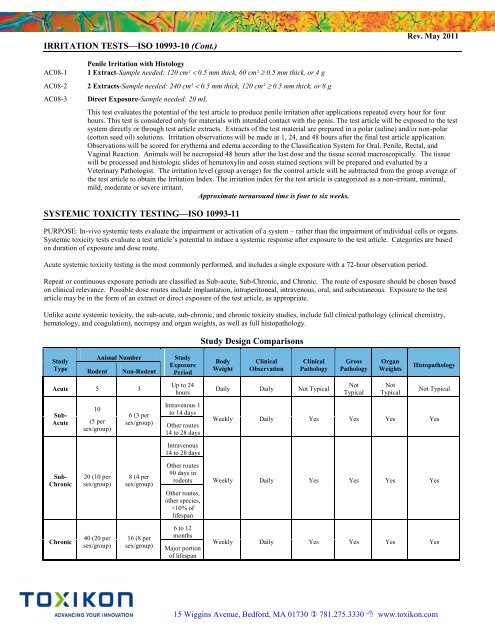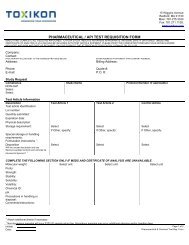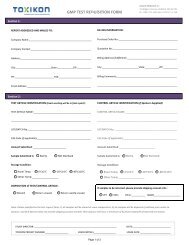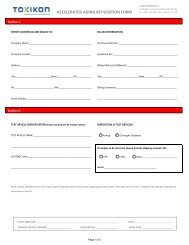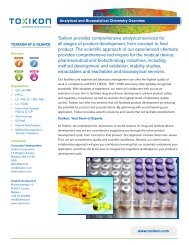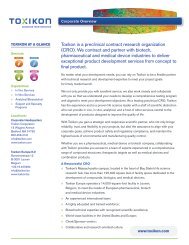Medical Device Testing Guide - Toxikon Corporation
Medical Device Testing Guide - Toxikon Corporation
Medical Device Testing Guide - Toxikon Corporation
Create successful ePaper yourself
Turn your PDF publications into a flip-book with our unique Google optimized e-Paper software.
IRRITATION TESTS—ISO 10993-10 (Cont.)<br />
Rev. May 2011<br />
AC08-1<br />
AC08-2<br />
AC08-3<br />
Penile Irritation with Histology<br />
1 Extract-Sample needed: 120 cm² 0.5 mm thick, 60 cm² 0.5 mm thick, or 4 g<br />
2 Extracts-Sample needed: 240 cm² 0.5 mm thick, 120 cm² 0.5 mm thick, or 8 g<br />
Direct Exposure-Sample needed: 20 mL<br />
This test evaluates the potential of the test article to produce penile irritation after applications repeated every hour for four<br />
hours. This test is considered only for materials with intended contact with the penis. The test article will be exposed to the test<br />
system directly or through test article extracts. Extracts of the test material are prepared in a polar (saline) and/or non-polar<br />
(cotton seed oil) solutions. Irritation observations will be made at 1, 24, and 48 hours after the final test article application.<br />
Observations will be scored for erythema and edema according to the Classification System for Oral, Penile, Rectal, and<br />
Vaginal Reaction. Animals will be necropsied 48 hours after the last dose and the tissue scored macroscopically. The tissue<br />
will be processed and histologic slides of hematoxylin and eosin stained sections will be prepared and evaluated by a<br />
Veterinary Pathologist. The irritation level (group average) for the control article will be subtracted from the group average of<br />
the test article to obtain the Irritation Index. The irritation index for the test article is categorized as a non-irritant, minimal,<br />
mild, moderate or severe irritant.<br />
Approximate turnaround time is four to six weeks.<br />
SYSTEMIC TOXICITY TESTING—ISO 10993-11<br />
PURPOSE: In-vivo systemic tests evaluate the impairment or activation of a system – rather than the impairment of individual cells or organs.<br />
Systemic toxicity tests evaluate a test article’s potential to induce a systemic response after exposure to the test article. Categories are based<br />
on duration of exposure and dose route.<br />
Acute systemic toxicity testing is the most commonly performed, and includes a single exposure with a 72-hour observation period.<br />
Repeat or continuous exposure periods are classified as Sub-acute, Sub-Chronic, and Chronic. The route of exposure should be chosen based<br />
on clinical relevance. Possible dose routes include implantation, intraperitoneal, intravenous, oral, and subcutaneous. Exposure to the test<br />
article may be in the form of an extract or direct exposure of the test article, as appropriate.<br />
Unlike acute systemic toxicity, the sub-acute, sub-chronic, and chronic toxicity studies, include full clinical pathology (clinical chemistry,<br />
hematology, and coagulation), necropsy and organ weights, as well as full histopathology.<br />
Study Design Comparisons<br />
Study<br />
Type<br />
Animal Number<br />
Rodent<br />
Non-Rodent<br />
Acute 5 3<br />
Sub-<br />
Acute<br />
Sub-<br />
Chronic<br />
Chronic<br />
10<br />
(5 per<br />
sex/group)<br />
20 (10 per<br />
sex/group)<br />
40 (20 per<br />
sex/group)<br />
6 (3 per<br />
sex/group)<br />
8 (4 per<br />
sex/group)<br />
16 (8 per<br />
sex/group)<br />
Study<br />
Exposure<br />
Period<br />
Up to 24<br />
hours<br />
Intravenous 1<br />
to 14 days<br />
Other routes<br />
14 to 28 days<br />
Intravenous<br />
14 to 28 days<br />
Other routes<br />
90 days in<br />
rodents<br />
Other routes,<br />
other species,<br />


